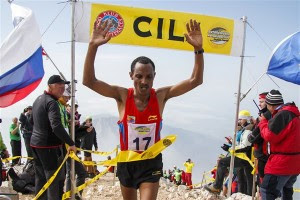10m interval within broader 41m down-hole intersection of stringer and disseminated sulphides
Symbol: ASX: CHN TSX: CXN Shares outstanding: 250 million Fully diluted: 255 million
PERTH, Western Australia, Oct. 31, 2012 /CNW/ - Chalice Gold Mines Limited (ASX: CHN; TSX: CXN) is pleased to advise that it has intersected a zone of massive pyritic sulphides with significant copper and zinc values in drilling at its Mogoraib North Project in Eritrea, East Africa (Chalice - 60%; Eritrean National Mining Corporation (ENAMCO) - 40%).
Diamond drill hole MOGD-00021, part of a regional drilling program targeting potential Volcanic Hosted Massive Sulphide ("VHMS") systems similar to the world-class Bisha Mine (Nevsun 60%: ENAMCO 40%) located 15km to the south, has intersected a 10 metre interval of massive pyritic sulphides within a broader 41 metre wide zone of stringer and disseminated sulphides (Figure 3).
The massive sulphides are hosted by a sequence of altered mafic rhyolitic and andesitic volcanics and contain visually identified chalcopyrite (copper iron sulphide) and sphalerite (zinc sulphide) (Plate 1).
Systematic Niton-XRF readings on 10 cm centres along the section 145.3m to 155.5m (10.2m interval) averaged 1.07% copper and 2.25% zinc (see cautionary note below).
Chalice's current drilling program is targeting Volcanic Hosted Massive Sulphide ("VHMS") systems similar to the Bisha, Harena and Hambok deposits to the south of Mogoraib North and is based on the commonly developed clustering of such deposits.
The new prospect lies along the interpreted Bisha geological trend, 15km north of the Bisha operations as shown in Figure 1. The characteristics of the sulphide mineralisation encountered in the Company's discovery hole (MOGD-00021) indicate a VHMS affinity.
The prospect currently being targeted is one of numerous bedrock conductor targets generated by a 3,825km Versatile Time-domain EM ("VTEM") survey flown by Chalice in 2011. In May 2012, following modelling and further refining and ranking of these targets, the Company embarked on a 5,000m diamond drilling program to systematically test these targets.
The VTEM anomaly tested by MOGD-00021, T209, is one conductor anomaly along a 4km strike length which hosts three other similar conductor anomalies (Figure 2). Several of these, including T209, are associated with coincident or adjacent gravity anomalies (Figure 4).
The Company is currently re-modeling the identified conductor targets within this zone based on the results from MOGD-00021 and will commence follow-up drilling immediately along strike. Sulphide-rich sections of the core from MOGD-00021 have been cut and assaying for a full multi-element suite will be expedited.
In addition, the Company will conduct a detailed ground gravity survey over the prospective 4km strike of the T209 cluster and is planning ground EM surveys as soon as appropriate equipment can be sourced.
Executive Chairman, Tim Goyder, said:
"This is an exciting moment for the Company. We applied for the Mogoraib North tenement on the basis of strong geological rational that alluvium covered areas to the north of Bisha should be prospective for VHMS mineralisation. The intersection in MOGD-00021 validates this belief and we look forward to undertaking further drilling to determine the extent of mineralisation and economic potential of this newly discovered zone."
Cautionary Note Mineralised drill core is being analysed using the portable Niton XLT hand-held XRF analyser (Niton). Chalice is confident to use the Niton as an indicator only of base metal mineralisation to report exploration results. Chalice's Niton procedure is to orientate and geologically log drill core and then use the Niton instrument to record spot readings taken over a 30 second period for a range of elements every 10-15cm. Results are averaged for intervals of drill core and reported on a minimum width of 1m. Full assays of half-cut NQ drill core (47mm diameter) will then be analysed by a commercial assay laboratory. The results provided here should not be relied upon other than as an initial indicator of significant levels of base metals in the core tested.
Competent Persons and Qualified Person Statement The information in this news release that relates to exploration results is based on information compiled by Dr Doug Jones, a full-time employee and Director of Chalice Gold Mines Limited, who is a Member of the Australasian Institute of Mining and Metallurgy and is a Chartered Professional Geologist. Dr Jones has sufficient experience in the field of activity being reported to qualify as a Competent Person as defined in the 2004 edition of the Australasian Code for Reporting of Exploration Results, Minerals Resources and Ore Reserves, and is a Qualified Person under National Instrument 43-101 - 'Standards of Disclosure for Mineral Projects'. The Qualified Person has verified the data disclosed in this release, including sampling, analytical and test data underlying the information contained in this release. Dr Jones consents to the release of information in the form and context in which it appears here.
Forward Looking Statements This document may contain forward-looking information within the meaning of Canadian securities legislation and forward-looking statements within the meaning of the United States Private Securities Litigation Reform Act of 1995 (collectively, "forward-looking statements"). These forward-looking statements are made as of the date of this document and Chalice Gold Mines Limited (the Company) does not intend, and does not assume any obligation, to update these forward-looking statements, except as required by law or regulation.
Forward-looking statements relate to future events or future performance and reflect Company management's expectations or beliefs regarding future events and include, but are not limited to, statements with respect to the estimation of mineral reserves and mineral resources, the realization of mineral reserve estimates, the likelihood of exploration success, the timing and amount of estimated future production, costs of production, capital expenditures, success of mining operations, environmental risks, unanticipated reclamation expenses, title disputes or claims and limitations on insurance coverage.
In certain cases, forward-looking statements can be identified by the use of words such as plans, expects or does not expect, is expected, budget, scheduled, estimates, forecasts, intends, anticipates or does not anticipate, or believes, or variations of such words and phrases or statements that certain actions, events or results may, could, would, might or will be taken, occur or be achieved or the negative of these terms or comparable terminology. By their very nature forward-looking statements involve known and unknown risks, uncertainties and other factors which may cause the actual results, performance or achievements of the Company to be materially different from any future results, performance or achievements expressed or implied by the forward-looking statements. Such factors include, among others, risks related to actual results of current exploration activities; changes in project parameters as plans continue to be refined; future prices of mineral resources; possible variations in ore reserves, grade or recovery rates; accidents, labour disputes and other risks of the mining industry, as well as those factors detailed from time to time in the Company's interim and annual financial statements, all of which are filed and available for review on SEDAR at sedar.com. Although the Company has attempted to identify important factors that could cause actual actions, events or results to differ materially from those described in forward-looking statements, there may be other factors that cause actions, events or results not to be as anticipated, estimated or intended. There can be no assurance that forward-looking statements will prove to be accurate, as actual results and future events could differ materially from those anticipated in such statements.
Accordingly, readers should not place undue reliance on forward-looking statements.
Sampling Procedures and Quality Assurance Diamond drill core is logged and photographed prior to splitting with a core saw. One half of the core is retained on site whilst the other half is bagged and dispatched to the Africa Horn Preparation facility (a division of NATA‐accredited Intertek‐Genalysis Laboratories) in Asmara for crushing to ‐2mm and splitting. Certified reference materials (CRMs) are submitted with all sample batches at the rate of 1 per 20‐25 routine samples. The CRM's inserted have values ranging from very low to high grade. The coarse reject is stored and the split sub‐sample is pulverized to a nominal 95% passing ‐75 micron using an LM2 pulverizer.
The pulverized pulp is further split into two 100g to 150g sub‐samples; a primary pulp sample is sent for analysis and a duplicate pulp sample is kept as a reference and the remaining fine (-75 micron) reject is stored. A quartz wash is pulverized between samples and is stored for random testing of preparation contamination.
The sample pulps are transported by air to NATA‐accredited Intertek‐Genalysis Laboratories in Perth Western Australia for assay. For drill core and RC samples used for resource analysis the majority of gold assaying is completed using a lead collection of 50g fire assay method with an atomic absorption spectroscopy (AAS) finish. Additional specified multi‐element assays are carried out by ICP‐OES on 25g sub‐sample prepared using aqua regia digest. Bulk density determinations using water immersion method are carried out on every metre of core within expected mineralisation and every 10m within waste zones. QA/QC monitoring is applied to all drill core assays as per the protocols described above.





 8:31 PM
8:31 PM
 Admin.
Admin.



